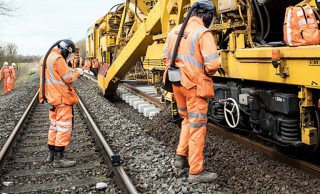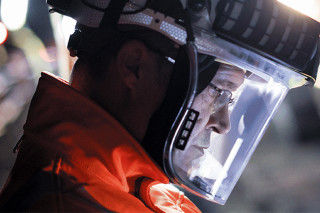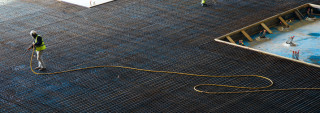Every year as many as 12,000 people die from lung disease caused by past exposures to harmful substances at work, according to the Health & Safety Executive (HSE). Construction workers are among those most at risk; each year around 3,000 people working in construction report breathing and lung problems they believe were caused, or made worse, by work.
Along with dust from cutting or grinding brick, concrete and stone, sanding wood, drilling and demolition, construction workers also face exposure to asbestos and various chemicals that can lead to lung cancer, silicosis, chronic obstructive pulmonary disease and asthma. The danger is not always immediately apparent; symptoms may take many years to appear.
But evidence is mounting on just how dangerous construction work can be to respiratory health.
In February 2019, HSE issued a safety alert on welding fume, after evidence from the International Agency for Research on Cancer showed exposure to mild steel welding fume could cause lung, and possibly kidney, cancer.
As a result, the Workplace Health Expert Committee, which advises HSE, has endorsed the reclassification of mild steel welding fume as a human carcinogen and HSE has strengthened its enforcement rules.
In practical terms, this means control measures must be in place for all welding, as there is no known level of safe exposure. Respiratory protective equipment (RPE) is required where local exhaust ventilation does not adequately control exposure indoors and must be provided for welding outdoors.
Employers are required to minimise employees’ exposure to hazardous materials under COSHH Regulations, the Control of Lead at Work, the Control of Asbestos Regulations and the Ionising Regulations.
While risk assessments will identify the measures that can be put in place to minimise and control respiratory hazards, it is almost impossible to eliminate exposure completely; providing suitable respiratory protective equipment (RPE) is crucial.
It is not enough to just provide the minimum levels of protection to meet legal requirements, however. Workers must understand how they might be exposed to harmful substances, the implications of that exposure and how to protect their long-term health and wellbeing – namely, by being trained in how to use the RPE they are issued with.
Tragically, a lack of training can be fatal. In May 2019 a contractor and a materials supplier were fined a total of £750,000, following the death of a 30-year-old floor layer in London in 2015.
The bathroom flooring adhesive that Paul Tilcock had been using contained large amounts of toxic dichloromethane. The decision as to whether to wear RPE and, if so, what type of RPE should be used, had been left to employees. The mask Tilcock was wearing was described by HSE investigators as “ineffectual”.
HSE inspector Peter Collingwood said: “This incident was wholly avoidable. It is important companies have an appreciation of their duties…and have effective systems and procedures in place to ensure [they] are fulfilled.”
RPE ranges from disposable masks, through to complete respiratory, head, eye and face protection, power-assisted respirators and breathing apparatus.
There are a number of standards and designations for RPE (see box) to help choose the most appropriate RPE for the task. Equipment must be CE marked and meet the latest EU PPE Regulation, which came into force in April 2019.

RPE filter classifications range from FFP1 to FFP3, equivalent to an Assigned Protection Factor (APF), denoting how much protection it offers. In environments with no respirable silicates, dusts, mists and fumes, disposable FFP1 or 2 masks are acceptable. But as soon as more harmful and irritant particle types are likely, an FFP2 mask must be used – the bare minimum in construction.

FFP3 RPE must be used where there are silicates, respirable dusts, mists and fumes. To put it simply, whenever materials are being cut which are not timber or metal, it is likely FFP3 protection is required.
And, for oxygen-deficient environments, confined spaces, highly toxic or contaminated environments and smoke-filled areas, positive pressure, self-contained breathing apparatus is essential.
All the regulations require face-fit testing. Getting a good fit is critical, as poorly-fitting RPE is the biggest cause of leaks. Fit is affected by other PPE being worn, such as eye, ear and head protection and many suppliers sell kits to check masks are fitted properly before work begins on site. HSE states workers wearing tight-fitting RPE should also be clean-shaven.
If there is uncertainty over the level of respiratory protection required, it is a good idea to discuss the risks and challenges with a specialist offering expert and independent advice on the best way to keep workers safe. A great way to do this is through a respiratory hazard audit.
• Damian Lynes is sales director of OnSite Support, a supplier of safety, welfare and site equipment and advice.
RPE standards
• BS EN36 covers full face masks (visors are covered under EN166).
• BS EN140 covers quarter or half-masks.
• BS EN149 covers facepieces with filters rated as FFP1, 2 or 3; masks will have an expiry date and be marked with ‘R’ if reusable or ‘NR’ if not (these are ‘single-shift’ masks).
• BS EN143 covers FFP rated filters for full face, half and quarter masks. They will be marked with a FFP rating (1, 2 or 3) and also ‘R’ or ‘NR’.
• BS EN14837 covers minimum requirements for gas and combination gas/particulate filters. Filters are classified into various types such as A, B, E, and K as well as categories such as filter capacities, depending on the chemical or solvent being protected against. Combination filters are available where a range of airborne, respirable hazards exist.
• EN12941 and EN12942 EN12941 covers powered filtering devices with helmets or hoods and EN12942 covers powered devices with just a mask. Specialist filters may be needed for solvents, chemicals, fumes, vapours or low-boiling-point fluids.
Got a story? Email news@theconstructionindex.co.uk




